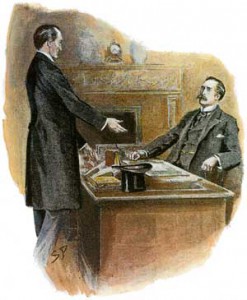The fictional character Sherlock Holmes is acknowledged as a genius of deduction, a master of disguise, an expert forensic scientist, the first private detective, and even a talented bare-knuckle boxer. However, Holmes is rarely recognized for his skill in using Six Sigma principles.
 Observation —When his cohort Dr. Watson asks how Holmes can see so much more when they both look at the same facts with the same eyes, Holmes explanation reveals a fundamental truth about Six Sigma. “You see but you do not observe. The distinction is clear.”
Observation —When his cohort Dr. Watson asks how Holmes can see so much more when they both look at the same facts with the same eyes, Holmes explanation reveals a fundamental truth about Six Sigma. “You see but you do not observe. The distinction is clear.”
Holmes asks Watson how many stairs lead up to their apartment. Even though he has climbed the stairs hundreds of times, Watson says that he has no idea. “Quite so,” says Holmes. “You have not observed. And yet you have seen.”
Six Sigma requires going beyond casually seeing how a process works. It demands focused observation that helps project teams understand the process and how it can be improved.
Gathering Data — Sherlock Holmes is known for making deductions from the information given to him, but that’s only part of the work he did. Holmes was also zealous while actively gathering the answers he needed to close a case. After consulting a client, Holmes would frequently throw on a disguise and dash off into the night only to return the next day with critical facts he had gotten by working his way closer to the problem or identifying a key person in the story.
Six Sigma project teams do the same thing, only without the fake beards and cosmetic noses. Instead, they actively gather data by tapping into information from organizational databases, surveys, interviews, listening posts and observations. Teams also record information about the process on check sheets and data sheets.
Project teams that go beyond obvious facts and simple assumptions, and dig deep for data that reveals how the process is truly performing, are better able to identify and solve the real problem.
Creating an Intelligence Network — Sherlock Holmes didn’t always rely on his own genius for solving crimes. Sometimes he enlisted the help of a most unlikely group, an army of street urchins. When Holmes needed information he couldn’t get on his own, he tapped into his network of wayward orphans and put dozens of pairs of eyes and ears on the street to learn what was happening.
Six Sigma experts create their own intelligence network to keep up with what’s going on in the company by including Green Belts, Yellow Belts and White Belts on the project team. A key strength of Six Sigma is that it doesn’t just include the leadership team; it is designed to get street-level intelligence from front-line workers. This includes a wide variety of players from all parts of the corporation who give the Six Sigma team diverse perspectives on the process.
If you need ideas to enliven a stalled Six Sigma project, you may simply want to ask yourself what Sherlock Holmes would do.



